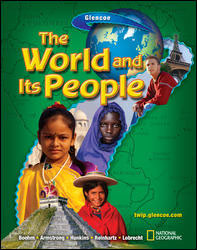
The World and Its PeopleChapter 2: Water, Climate, and VegetationChapter OverviewsWater covers about 70 percent of the earth's surface. The earth's water is continually moving though the processes of evaporation, condensation, precipitation, and collection. Together these steps are known as the water cycle. In order to survive, humans need freshwater. Almost 98 percent of the water on Earth, however, is salt water found in the oceans. Climate is the usual pattern of weather in an area over a long period of time. A combination of factors creates climate. Wind and ocean currents, the sun, latitude, and elevation all contribute to climate. People's actions can also affect climate. The burning of fossil fuels and the destruction of the rain forests are human actions that are causing concern. Geographers divide the world into different climate zones that are based on latitude, amount of precipitation, and elevation. Each zone shares common characteristics and has particular kinds of vegetation. The five major climate zones are tropical, mid-latitude, high latitude, dry, and highland. A delicate balance exists among the earth's hydrosphere, lithosphere, atmosphere, and biosphere. The challenge is to use the earth's resources without harming ecosystems and the global environment. |  |















